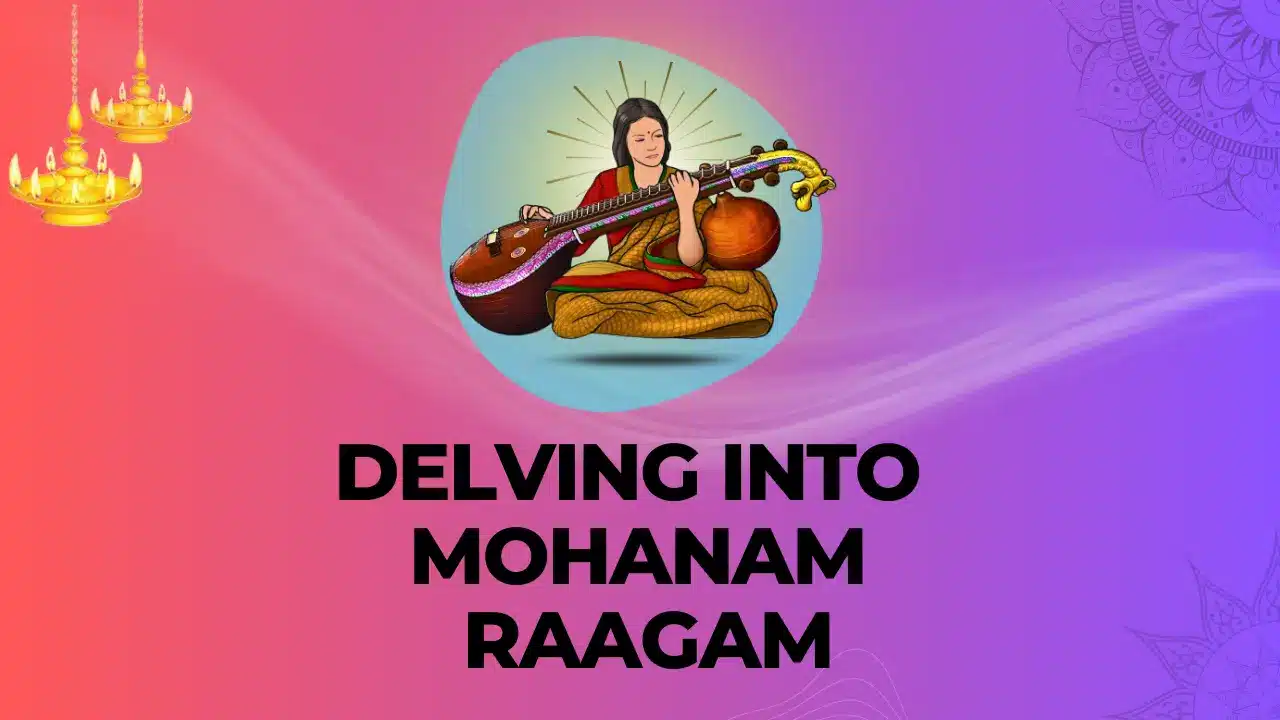- Parent Raag of Mohanam: Harikambhoji
- Grahabedam Effect of Mohanam
- The Melodic Structure
- Mohanam: The Global Favourite
- Emotions of Mohanam
- The Perfect Mohanam Time
- Mohana(m) Renditions
- Carnatic Raagam Mohanam | Compositions
- The True Story of Nannu Palimpa
- Mohanam | Film Music Compositions
- The Emotional Quotient of Mohanam
- Mohanam and Mental Health
- Final Notes
- FAQs
Delve into the sweet melody of the Carnatic Raagam Mohanam that translates to ‘Beautiful and Good looking’. The raga is so beautiful that it transforms the listener to take a carefree approach, mesmerised by the five swaras that define this Carnatic raga.
The unique scale is a tough one, keeping the performer on his/her toes to find the hidden beauty as a single note change would mean a different raga. So knowing the grammar of this scale is of utmost importance before you indulge in this playful scenario.

Music is a moral law. It gives soul to the universe, wings to the mind, flight to the imagination, and charm and gaiety to life and to everything.
Parent Raag of Mohanam: Harikambhoji
Before we get into the depths of Mohanam, let’s get to know about its parent scale. Harikambhoji, is almost thousand years old, is the 28th raga of the 72 Melakartha system comprising all seven notes. The raga is accommodates five scales including Mohanam, Suddha Saveri, Suddha Dhanyasi, Madhyamavathi and Hindolam into its family. This is where Mohanam gets tricky to perform as it can easily sway into other scales of its siblings.
Grahabedam Effect of Mohanam
Graha means position; Bhedha means change. In Carnatic music, a tonic note shifting to another note derives a different raag. This process is Grahabedham. In Hindustani classical music, this is Murchana.
This brings us to the question of why we are discussing Grahabedham in a Mohanam write-up. The reasoning behind it is the scale containing 5 swaras and the note shifts between them will bring other derivatives into the mix which again fall into the other janyas of Harikambhoji.
The Melodic Structure
Let’s see about this scale. Here is the ascending and descending order:
ārohaṇa : S R₂ G₃ P D₂ Ṡ
avarohaṇa : Ṡ D₂ P G₃ R₂ S
[Shadjam, Chathusruthi Rishabham, Antara Gandharam, Panchamam, Chathusruthi Dhaivatham]
As you can see Madhyamam and Nishādham are missing, this scale falls under the Aowdava category comprising five swaras, popularly called a pentatonic scale in Western music.
The Anthara Gandharam has the most importance in Mohanam raag. For a composer, it is a good practice to start his/her composition in Ga and for a performer, the note Ga is a good resting place in a Mohanam aalapana as it oozes the essence of the scale immediately.
Mohanam: The Global Favourite
Carnatic Raagam Mohanam had different names over the eras of mankind including “regupti” or “reghupati” and Mullai Pann in ancient times [mentioned in Dr S. Ramanathan’s doctoral dissertation on the music in silappadikAram]. It has travelled around the world touching the primitive tribe culture. Traces of the raga is in ancient Chinese, Japanese, Hungarian, Swedish, and gipsy societies. It is also in Asian countries like Burma, Thailand, Japan, and China. In fact, the national anthem of Thailand is in this scale, making it a global scale of many eras of human history.
Emotions of Mohanam
When it is time to relax or unwind after a long day, there is nothing better than listening to an aalap of the Carnatic Raagam Mohanam. Its healing powers are immense across the world. It uplifts the listener’s mood almost instantly and embraces you in its arms. From a simple geetham to a complex symphony, this scale takes many avatars, bringing a smile to every listener.
For me, it takes me back to my childhood days of learning Carnatic music. One of the first Varnams they teach is Ninnu Kori by Ramnad Sreenivasa Iyengar. In most of the schools, this learning pattern is extremely prevalent.

Did You Know?
Saint Purandara Dasa, referred to as the “Father of Carnatic Music”, composed thousands of keertanas or devotional songs and also formulated the basic lessons of Carnatic Music.
The Perfect Mohanam Time
The Carnatic raagam Mohanam can soothe your mind. But as a practice, it is a night/dusk Raagam, more like a lullaby that helps good thoughts flow into your mind, dreams and soul.
Mohana(m) Renditions
This old raag has been in the vicinity for years given a world of compositions in world music and classical music.
Carnatic Raagam Mohanam | Compositions
Did you know? One of the first music lessons that Carnatic musicians teach, especially on the auspicious day of Vijayadhsami (the last day of Dusshera) is Vara Veena in Adi Thaalam. The song’s composer is by Appiah Dikshitar.
After a couple of short songs (Geetham), the syllabus moves on to Varnam. A famous Varnam and a film song on the same scale is Ninnu Kori – the former by Ramanathapuram Srinivasa Iyengar and the latter by Isaignani Illaiyaraja.
Here are some of the versatile Carnatic compositions in the raag:
- Nanupalimpa, by Saint Tyagaraja
- Raa Raa Rajeevalochana by Mysore Vasudevacharya
- Kapali, Narayana Enum Divya Namam by Papanasam Sivan
- Swagatham Krishna by Oothukkadu Venkata Subbaiyer
- Oodi Baarayya by Purandara Dasar
The True Story of Nannu Palimpa
When Saint Tyagaraja was eagerly awaiting his disciple Venkataramana’s return for his daughter’s wedding, he arrived late. However, he was carrying a portrait of Sri Rama as a gift. Tyagaraja’s merriful composition is ‘Nanupalimpa nadachi vacchitivo,’ which translates to ‘You walked all the way to save me.’ Nadaswaram players choose this song to play in weddings.
Mohanam | Film Music Compositions
Many music composers have come up with a long list of songs over the years composed in pure Mohanam.
The melodic Giridhara Gopala is a classic from the movie, Meera, in which the legendary Carnatic prodigy, the late, M. S. Subbulakshmi, has screened and sang. This is one of the few film songs that Carnatic musicians perform in concerts.
M. S. Viswanathan was another composer who has been an inspiration to many musicians. Some of his notable compositions would include Paadumbodhu Naan Thendral Kaatru” from Netru Indru Naalai, “Acham Enbadhu Madamayada” from Mannadhi Mannan movie.
- Gangai Yamunai from Imayam composed by MSV
- Thiruchendoorin Kadalorathil Senthilnaathan from Dheivam composed by Carnatic violinist, Kunnakudi Vaidhyanathan
- Kanmaniye Kadhal Enbadhu from Aarilirunthu Arubathu Varai composed by Illaiyaraja
- Oru Thanga Rathathil from Dharma Yutham composed by Illaiyaraja
- Geetham Sangeetham from Kokarako composed by Gangai Amaran
- Sivappu Lolaku from Kaadhal Kottai composed by Deva
- Endrendrum Punnagai from Alai Payuthey composed by Pravin Mani
- Pakkada Pakkade from Gentleman composed by AR Rahman
- Engeyum Kadhal from Engeyum Kadhal by Harris Jayaraj
- Yaar Arindhadho from Thalaikoothal by Kannan
The Emotional Quotient of Mohanam
Mohanam is basically a Veera rasa pradhana raga. It means the scale exudes courage in the Navarasa (9 emotions) system. This Raagam expresses emotions like Shringara(Beauty), and Karunya(Compassion). Folk artists use this raga for its simplicity and happy vibes.
Mohanam and Mental Health
Mohanam, known as Bhoopali or Bhoop in Hindustani classical music, is a scale that calms down patients who are suffering from depression. It soothes your nerves and fill your mind with transcending tranquillity.
Final Notes
The raga Mohanam is a scale that we love and adore because of its beauty with which love coexists. It is easy on your ears personifying a pleasant breezy evening through music. So are you ready to learn this beautiful scale in depth?
Here is where you can find the notes and notations of Era Napai, a famous Thodi Varnam
FAQs
What is the history and origin of the Mohanam ragam?
Mohanam is one of the oldest scales reeling back to 3 BCE with the notes of sa ri ga pa da equivalent to C, D, E, G, and A in the western notations. It was also referred by the name Raghupathi.
What are the characteristics of Raag Mohanam?
Mohanam is recognised as a happy raga that soothes and uplifts the listener’s mood to happiness. As the raga comprises 5 swaras, it is called an Audava ragam.
Can you explain the melodic structure of Raag Mohanam?
The scale has five swaras. The arohana and avarohana of this scale are:
ārohaṇa : S R₂ G₃ P D₂ Ṡ
avarohaṇa : Ṡ D₂ P G₃ R₂ S
[Shadjam, Chathusruthi Rishabham, Antara Gandharam, Panchamam, Chathusruthi Dhaivatham]
Which Carnatic compositions are based on Raag Mohanam?
There are innumerable compositions based on Mahanam raga. Some of the famous songs include Nanupalimpa, by Saint Tyagaraja, Raa Raa Rajeevalochana by Mysore Vasudevacharya, Kapali, Narayana Enum Divya Namam by Papanasam Sivan, Ramanathapuram Srinivasa Iyengar, and Vara Veena by Appiah Dikshitar.
How does one identify Raag Mohanam in classical music performances?
The usage of Antara Gandharam is one of the easiest ways to identify the raga. Another method is to see if you can recognise any famous film song like Ninnu kori varnam from Agni Nakshatram composed by Illaiyaraja. It has helped me.
What are some common phrases and phrases used in Raag Mohanam?
One can make many combinations of this simple raga. Some of the common phrases include Ri Ga Pa, Sa Ri Ga, Da SA Da, and SA RI Sa. [SA represents the highest shadjamam followed by the same pattern for other notes]
Are there any popular film songs based on Raag Mohanam?
There are many famous film songs including the groovy Athan Varuvaha from Dum Dum Dum composed by Karthik Raja, melodious Ninnu kori varnam from Agni Nakshatram, and Boom Boom song from the movie Boys composed by Illaiyaraja.
Related Blog: Evvari Bodhana – Abhogi Ragam































